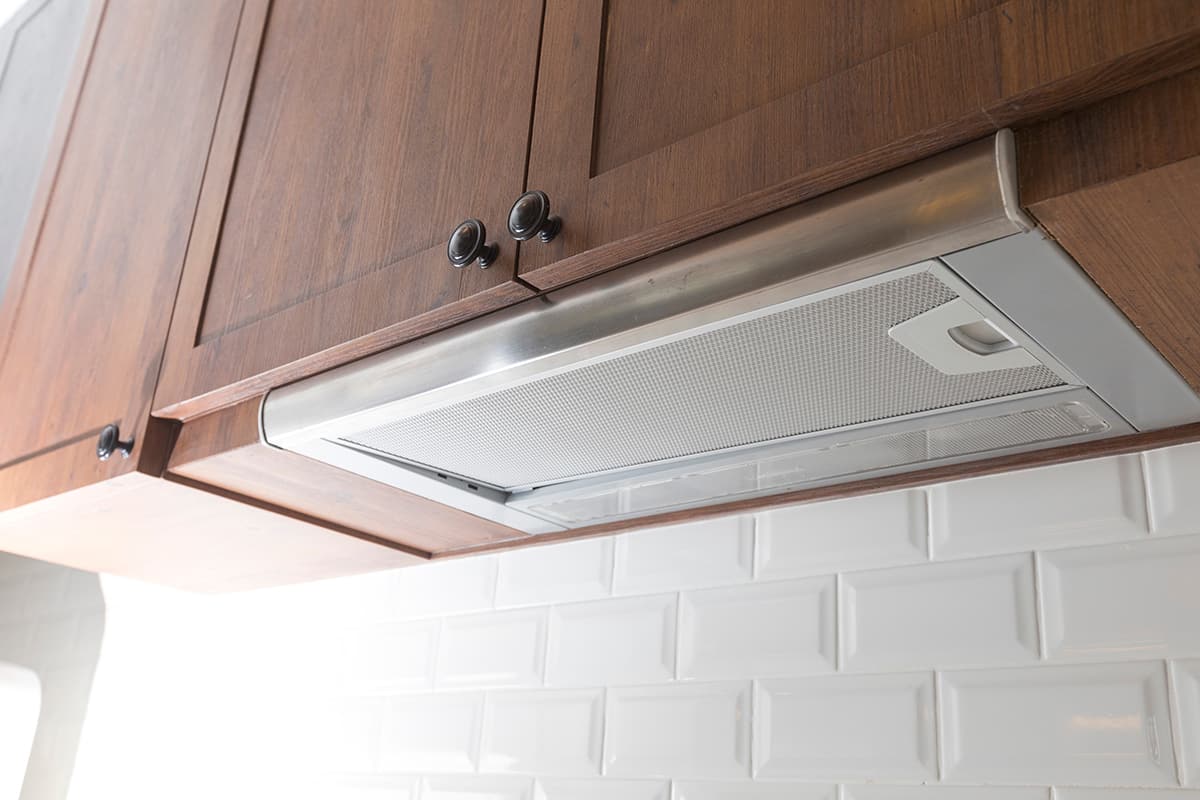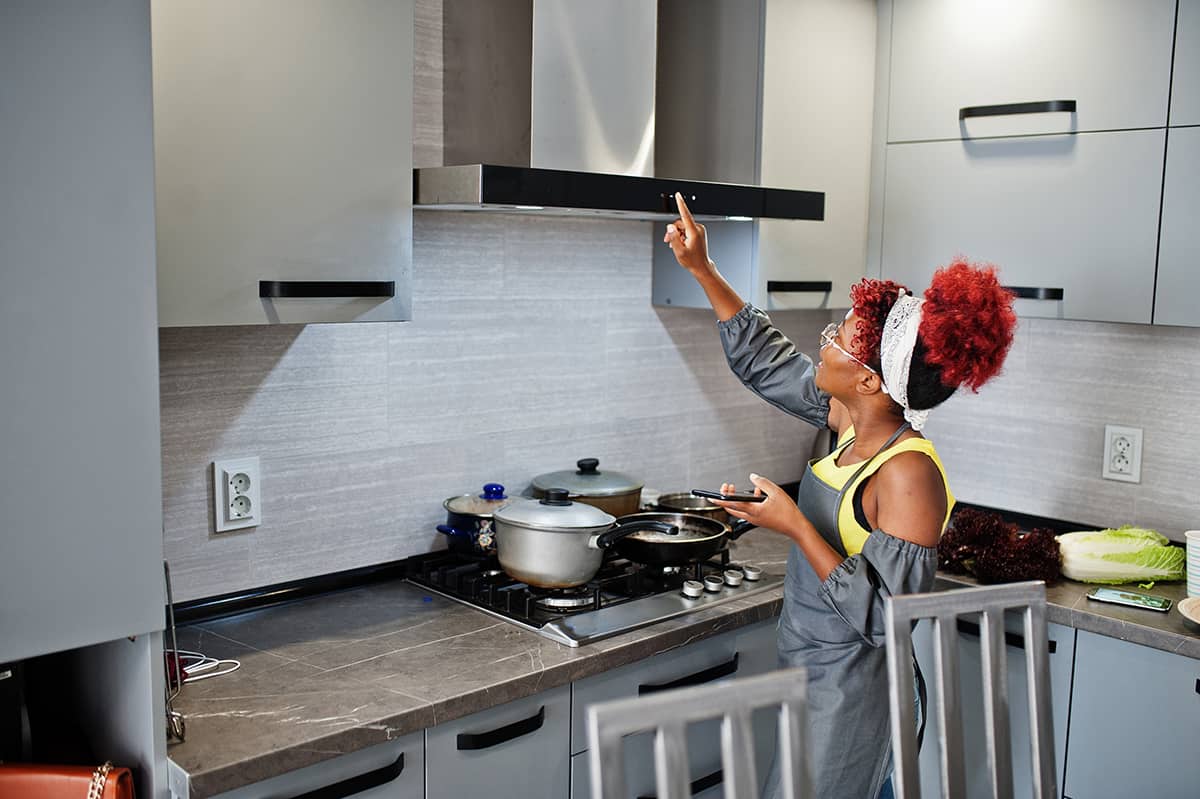A range hood is a must-have appliance if you’re not particularly handy in the kitchen. It will suction away smoke and odors from the source (your stove), so you won’t wrinkle your nose every time you step foot in your kitchen. But before you install a range hood above your stove, you should first familiarize yourself with its dimensions.
Range hoods are measured by their widths, which are between 24 and 60 inches. The most common range hood sizes range between 20 and 30 inches wide. Ideally, your range hood will be at least 6 inches wider than your stove.
However, the width of a range hood isn’t the only measurement you should be aware of. In this guide, I’ll explain what a range hood is, how to choose a range hood for your kitchen, and how to choose between range hood configurations.
What Is a Range Hood?

After countless kitchen experiments, you’ve probably come to the realization that cooking food produces lots of stains and lingering odors. And it only takes a single cooking project to leave your stove filthy and the air nose-wrinkly foul. If this describes your kitchen in a nutshell, then you probably need a range hood.
A range hood is a kitchen appliance that mainly consists of a canopy-like hood and a fan. You install it above a cooktop so that the fan will suction in smoke, odors, and grease. Depending on the model, a range hood will dispose of the contaminants by tossing them outdoors or purifying the air by passing it through a series of filters.
Here are a few reasons why you should think about getting a range hood for your stove.
Improves air quality
If you thought slaving in front of a hot stove was the only bad thing about cooking, then you’ve never spent a moment in the kitchen. The longer your stove or oven is on, the more heat and airborne contaminants it produces. A ceiling fan would just circulate the smoke, odors, and pollutants throughout your kitchen, whereas a range hood eliminates them directly from the source.
Allows you to experiment with a wider range of recipes
Since range hoods get rid of nose-wrinkling odors in your kitchen, you are free to experiment with exotic ingredients that would otherwise leave a lingering scent. So, if you’ve dreamed about making Indian cuisine at home, you won’t need to worry about offending your guests’ noses with exotic spices.
Illuminates your cooking station
You can never have too many lights in the kitchen. The more lights there are, the better you can see what you’re doing. Since many range hoods come with built-in LEDs, you can see exactly how far your food has progressed in the skillet or pot.
Boosts aesthetics
Let’s be honest here—many people get range hoods just for the appeal. Range hoods undoubtedly make kitchens look classier and more professional, but they can also boost the value of your home.
Range Hood Dimensions
Before deciding which range hood to add to your kitchen, you should first familiarize yourself with what sizes they come in.
Range hoods are usually measured by their width since it directly correlates to how much air it will vent. For the most part, range hood come in 24, 30, and 36-inch models. That said, you can easily find massive range hoods measuring 40 to 60 inches wide!
But the width of a range hood is only a fraction of its overall dimensions. You should also note the height and depth of a range hood model before installing it in your kitchen.
The precise measurements will depend on the model and its style. Here’s a quick breakdown of the range hood depths and heights based on style.
| Range Hood Style | Depth | Height |
| Wall-mount | 24 to 26 in. | 24 to 30 in. |
| Island | 24 to 26 in. | 26 to 28 in. |
| Under-cabinet | 12 to 15 in. | 24 to 30 in. |
| Over-the-microwave | 16 to 20 in. | 12 to 15 in. |
| Retractable | 20 to 24 in. | 14 to 18 in. |
The figures in the chart are only rough estimates. There are several range hood models that are smaller or larger than the measurements above.
How to Choose a Range Hood

If you’ve decided to invest in a range hood, it’s time to choose the right size. The only tool you need is a measuring tape.
- Measure the width of your stove
Most home-grade range hoods measure between 20 and 36 inches wide, but you will have to figure out the exact width of your stove. This will give you a good idea of how wide the range hood should be.
- Measure the width of space between the wall cabinets
Although your stove may be a certain width, it’s even more important that you figure out how much above-stove space you have to fit your range hood. So, take your measuring tape and figure out the space between the wall cabinets.
Ideally, your range hood should measure 6 inches wider than your stove. For instance, if your stove is 30 inches wide, you should find a 36-inch-wide range hood. So, the area between your wall cabinets should be slightly wider than your stove. If you don’t have wall cabinets, proceed to the next step.
- Measure the height of the space above your stove
Now, let’s figure out how tall of a range hood you can install in your kitchen. Measure the distance between the top of your stove’s burner and the ceiling. Depending on where you live, building codes may require that you install a range hood at a minimum distance above your stove. In many cases, that figure will depend on what type of stove you own.
- Electric—at least 20 inches between the top of the stove and the bottom of the range hood
- Gas—at least 24 inches
- Gas-Electric—36 inches at most
- Measure the depth of your stove
Lastly, you should measure how deep (front to back) your stove is. Range hoods should be at least as deep as your cooktop to provide maximum coverage and venting performance. When in doubt, find a range hood slightly larger than your stove in terms of depth.
Ducted vs. Ductless Range Hood Configurations
While the dimensions of a range hood will tell you whether or not it will fit in your kitchen, there’s one more important factor to consider, which ultimately determines which range hood you end up with—the configuration or whether it’s a ducted or ductless unit.
Ducted range hoods
Ducted range hoods are, by far, the superior of the 2 configurations. It connects to your home’s HVAC system in order to dispose of odors and airborne pollutants. The hood’s fan suctions air, which passes through a connection pipe and eventually leads to an outdoor vent.
The tradeoff for superior performance is upfront and installation expenses. In addition, ducted range hoods can only be installed in parts of your kitchen that have easy access to your home’s duct system. In the end, you might have to rearrange your kitchen layout to install a ducted hood properly.
Ductless range hoods
Ductless range hoods are similar to air purifiers. A fan suctions air from your kitchen before passing it through a series of filters. The multi-filter system captures solid particles before sterilizing the odors. The air is then recirculated into your kitchen. Best of all, you can install a ductless range hood anywhere you want (as long as there’s enough space).
One huge downside of ductless range hoods is that you will need to replace the filters periodically. In addition, the filter can become clogged more easily when it suctions steam.






